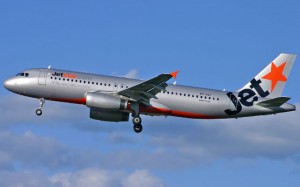
Jetstar says that a serious incident at Melbourne Airport in 2007 which was initially not reported to the ATSB has seen it change its procedures for handling go-arounds and training of its A320 crews.
The ATSB released its final report on the incident on March 5, which occurred on July 21 2007 at Melbourne Airport. While the aircraft – A320 VH-VQT operating JQ156 from Christchurch – was on final to land at Melbourne, the pilot in command (PIC) was unable to establish visual reference due to thick fog, forcing the crew to initiate a go-around. However, go-around procedures were not completed correctly, with the throttles not fully advanced to the TOGA (takeoff/go-around detent), and in the process the crew failed to realise that the aircraft was continuing to descend until it was within 38ft of the ground.
“The intent by the PIC to carry out a TOGA (take-off/go-around) tap procedure ought normally to have meant that the thrust levers were momentarily moved from the CL (climb) detent to the TO/GA detent, and then back again,” the ATSB report reads. “However, in this instance, their movement to slightly beyond the FLX/MCT (flexible-maximum continuous thrust) detent meant that the aircraft’s automated systems did not make the mode transitions that were anticipated by the flightcrew. In particular, the vertical navigation mode did not transition from ‘glideslope’ to ‘speed-reference-system’.
“Approximately 48 seconds elapsed from the time that the PIC performed what was intended as a TOGA tap, with the intention of initiating a go-around, until the PIC again advanced the thrust levers; this time to the full extent necessary to reach the TO/GA detent, and hence engage the speed-reference-system vertical mode.” Continued the report, “neither the PIC nor the copilot confirmed the aircraft’s flight mode and, in the first eight seconds of that period, the aircraft gained airspeed and continued to descend to within 38ft of the ground.”
The crew subsequently made a second approach to land at Melbourne, but the fog again forced a missed approach, and the A320 diverted to and landing safely at Avalon airport.
The incident was reported internally, and five days later Jetstar reported it to the ATSB. A subsequent internal investigation found that the aircraft’s Enhanced Ground Proximity Warning System had been activated although this was not reported to the ATSB. Following media reports a few weeks later, the ATSB sought additional information from Jetstar and subsequently started an investigation.
The investigation subsequently found that a change in standard operating procedure by Jetstar for go-arounds “resulted in the flightcrew being unaware of the flight mode status of the aircraft during the first part of the first missed approach.” It also found that, “Flightcrew undergoing initial endorsement training with the third party training provider were not trained to the procedures and systems used by the operator”; and that Jetstar “did not comply with the incident reporting requirements of its safety management system, which was part of its operations manual, or with the reporting requirements of the Transport Safety Investigation Act 2003.”
Jetstar subsequently adopted Airbus’s standard procedures for go-arounds, and has confirmed to the ATSB that it was conducting a review of its third party training procedures.
After consultations with Jetstar about the incident, Airbus also revised its go-around procedure for the A320 to, according to the ATSB, “emphasise the critical nature of the actions by flight crew during a go-around.”










